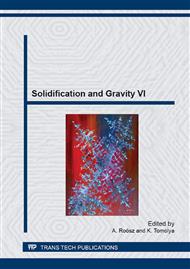p.205
p.211
p.217
p.223
p.229
p.235
p.241
p.247
p.253
Analysis of the Effect of Cooling Rate on Microstructure in 17% Cr Ferritic Cast Steel
Abstract:
High Cr and Ni content steels are widely used in many manufacturing processes in the chemical and petrochemical industry. The automotive industry has also recognized the necessity of heat resistant alloys for a long time, for example, to apply them to exhaust systems to endure thermal loading and oxidation during the operation of engines. Various heat resistant alloys such as cast irons, stainless steels, and Ni-base super alloys have been considered as candidate materials of automotive exhaust systems. Among those candidates, ferritic stainless steels attracted a lot of attention due to their favorable low thermal expansion, sufficient mechanical strength at elevated temperature and excellent corrosion resistant properties [1]. Currently they are the leading engineering materials in several fields of applications that require resistance to wear, corrosion [2,3], creep or thermal fatigue [4]. The high corrosion resistance of these steels is due to alloying elements such as Cr, Ni and Mo. If the ferritic stainless steels are alloyed with strong carbide-forming elements, such as Mo, Ti, V and Nb, hard phases, MC carbides can be obtained in the soft ferrite phase [5,6]. The improvement of the properties of FeCrNi cast steels is directly related to the development of the microstructure, which mainly consists of a ferritic matrix and carbides and/or dispersed intermetallics [7,8]. The improvement is not always the hardening. The hardness is usually limited by the casting and the subsequent machining, so an annealing process is also inserted.
Info:
Periodical:
Pages:
229-234
Citation:
Online since:
May 2014
Authors:
Price:
Сopyright:
© 2014 Trans Tech Publications Ltd. All Rights Reserved
Share:
Citation:


